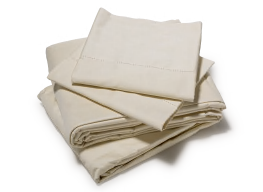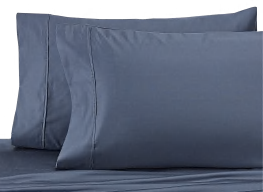5 Things to Know Before Buying Sheets
CR's experts share what they discovered when testing sheets in the lab—and how you can apply these rules when you shop for a new set
When you shop through retailer links on our site, we may earn affiliate commissions. 100% of the fees we collect are used to support our nonprofit mission. Learn more.

It’s easy to find good-looking sheets, but it’s tough to judge the quality of a new set in the store, let alone when shopping online. Material, thread count, weave—sure they matter, but how does it all fit into the quality of your bedding? At Consumer Reports, we tested sheet sets ranging from a little over $50 to more than $300 and found an extremely wide range of performance unrelated to price—or thread count.
CR’s testers noted that they could not find any correlation between manufacturer claims of materials or thread count and sheet performance. When analyzing the sheet sets, they also noticed that details, such as the corner seam distance or the elastic bands on the underside of the sheet, can vary widely, making it difficult to tell what’s useful or not when you’re shopping.
How CR Tests Sheets
We test the most popular size of sheets: queen. And we consider fit to be the most important standard. If a fitted sheet (no matter how soft) shrinks so much that you can’t get it over your mattress, all other attributes are moot.
1. Sheets Can Shrink Significantly
Cotton sheets we tested shrank up to 6 percent, and some no longer fit on even the thinnest mattress—an 8-inch-tall foam model—after just 15 washes.
Our testers noted that initially, all cotton sheets could fit the depth of the queen-size mattress as marked on their packaging (though not all packages carry such an indication). But after 25 wash cycles, only a few could fit a 14-inch mattress, and only the Matouk Sierra set could fit an 18-inch mattress (even though it shrank a fair amount). That’s something to keep in mind if you have a particularly thick pillow-top mattress.
CR members can check out the ratings of the Matouk Sierra sheets below:
The sheet set that shrank the least in our tests was the L.L.Bean Pima Percale. But it didn’t fit an 18-inch mattress after a year’s worth of washings, which our testers attribute more to the design of the sheets than to shrinkage.
2. Materials Make a Big Difference
The most common materials used for sheets, such as cotton, cotton blends, rayon, and polyester, have different properties. While we’ve only rated cotton sheets so far, our engineers have evaluated other common materials in the lab.
The sheets tested made of bamboo viscose were highly absorbent (so expect long drying times) and shrank by more than 15 percent after our
Cotton sheets, on the other hand, shrank less—but still, only the top sheets in our ratings could fit a 14-inch mattress after a year’s worth of washing.
The polyester sheet we tested hardly shrank at all, and fit an 18-inch mattress after a year’s worth of washing—though some might find sweating on a polyester sheet to be uncomfortable because the material doesn’t absorb water.
3. Thread Count Does Not Indicate Performance
One of our top-rated sheet sets, the Matouk Sierra, has a claimed thread count (the number of vertical and horizontal threads that go into each square inch of material) of 350.
Compare that with the Wamsutta Dream Zone 1000TC, with its claimed thread count of, yep, 1,000. The Wamsutta sits near the bottom of our ratings. The package for these sheets claims that they could fit up to a 20-inch-deep mattress, but in our testing, we found that the Wamsutta didn’t fit even an 18-inch mattress after fewer than 20 washes.
4. Price Doesn’t Indicate Performance
At about $300 the Wamsutta Dream Zone 1000TC Pima Cotton sheet set is one of the most expensive in our ratings, but it isn’t close to being the best. The sheets from L.L.Bean performed better than the Wamsutta sheets during testing, and they cost roughly half the price.
Toward the bottom? Casper’s Cool Supima sheets can run you close to $100 and don’t fit even an 8-inch mattress after a year’s worth of washing. All three brands’ sheets are made from the same material, but the difference in performance suggests a lot of variation in how sheets are manufactured.
5. The Feel of Cotton Remains Consistent
We handled sheets before and after washing for our sensory perception test. A panel of staffers compared each sheet set with three reference fabrics, then rated each set on a scale of soft, softer, and softest.
Of the sheets we tested, our panelists didn’t notice a significant difference in softness before and after a year’s worth of wash cycles. That means that if you’re feeling a set of sheets in a store, you can expect them to feel the same even after laundering them for about a year.





















